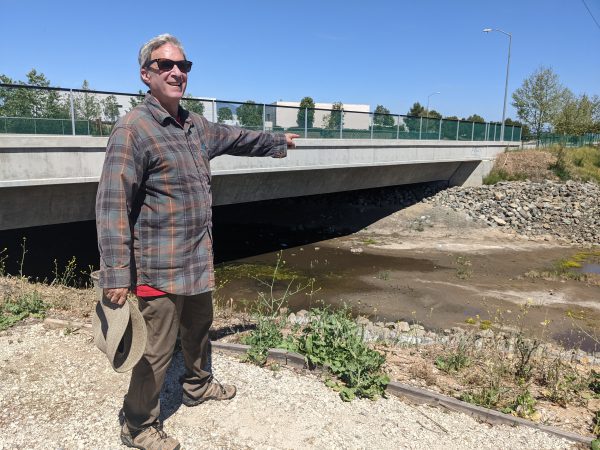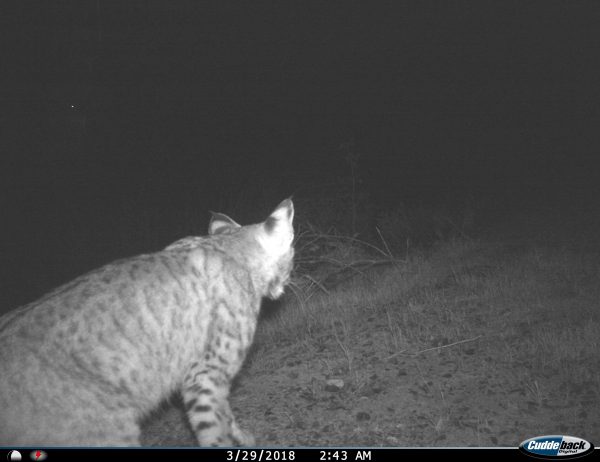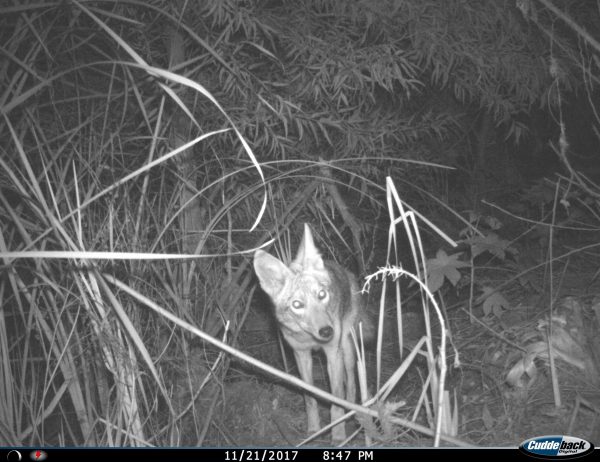
If the stars align and all the pieces fit, a native wild animal corridor will wend its way over six miles from the Santa Ana Mountains in the Cleveland National Forest to the Laguna Coast Wilderness Park, hopefully sooner than later.
The idea is to get wild animals, such as bobcats and gray foxes, from the national forest in the east to intermingle with the locals in the west, broadening their mating range and stopping the deleterious effects of interbreeding.
It’s coastal wildlife’s last dance, said Norm Grossman, president of Laguna Greenbelt, Inc., a nonprofit environmental conservation group. “If we don’t do anything, in 40 years wildlife here will consist of coyotes and bunnies.”
There are fewer than 30 bobcats and gray foxes each left on the 22,000 acres of the Laguna Coast Wilderness Park, according to Kevin Clark, director of bioservices at the San Diego Natural History Museum.

Clark worked with John Foley from the Laguna Greenbelt on a study analyzing thousands of photos from 21 wildlife cameras of animals traversing to and from the two wilderness areas. The study took place over an 18-month period three years ago. They saw coyotes daily. “The other critters? Not so much,” Foley said.
Environmentalists consider the Laguna wilderness an ecological island, or bubble, which isolates wildlife and results in interbreeding-fueled birth deformities, compromised immune systems and infertility.
“It’s a monoculture,” Grossman said. “Any tiny disease wipes out the entire species.” Genetic diversity cleans that all up.
But the biggest obstacle to nudging greater biodiversity toward Laguna is an 1100-foot, dark, completely graffiti-tagged tunnel that runs under 17 lanes of traffic at the El Toro Y where the I-5 and 405 freeways converge.
No wild animal would be caught dead in there, Clark said.
“I don’t know if we can do anything with that tunnel to make it suitable for wildlife to go through on a regular basis,” he said.
But to preserve the time and money invested in the Laguna wilderness for 30 years, local environmentalists agree, it’s worth trying, especially since other options would be a massive engineering undertaking.
The real snag is people. Taggers will be tagged regularly by Irvine police, said Lance Vallery, Laguna Greenbelt board member and urban planner instrumental in furthering the plan.
“The thing that jumped out at me from the camera study was that people were the number two species in the corridor,” he said.
Next, the dark tunnel needs to become inviting or at least passable by coyotes, bobcats and foxes. Moon-glow lighting, logs and rocks animals can hide in and shelving and ramps they can climb onto were among the recommendations from a 13-member Science Advisory Board. Planting cactus at the openings to deter humans is also on the list.
“We need to put in the effort to make it so inviting the animals see it as a temporary difficult spot to get through but they can see the other side,” said Clark, who is a member of the advisory board. “We can make it functional enough to get animals across coming from the Santa Anas.”
The ultimate goal is genetic connectivity and if that happens once every five years, a bobcat generation, goal accomplished, he said.
The west side of the corridor begins at Barbara’s Lake, the only natural lake in Orange County, where it leaves Laguna Coast Wilderness and heads east. A couple miles up, the riparian trail comes to an overpass on Lake Forest Drive, which is where the people problems start. It’s called a pinch-point.
The wash there is often water-filled from rain and run-off and bolstered on the banks by manmade riprap rock, both of which animals don’t like to cross.
“Right here, a homeless person had his whole camp set up,” said Foley, looking at a sandy spot on the shore. “He had his chair, he had his cooler, he had his stuff spread out. When a wild animal sees that, he’s going to turn back and go the other way.”
From that overpass, the corridor traverses more riparian creek bed until it hits the major pinch-point, “the big, scary tunnel,” as it’s been dubbed by Greenbelt members. On the other side of the tunnel, the corridor travels up a creek bed next to strawberry fields, enters a short tunnel under Irvine Boulevard and onto a dedicated wildlife trail at the Great Park in Irvine.
Then, through a series of tunnels under the 241 toll road, the corridor finally hooks up to the Santa Ana Mountains and 250,000 acres of national forest.

The Wildlife Corridor is the brainchild and passion of Laguna Greenbelt member and scientist Elisabeth Brown and, together, championed by Mary Fegraus, founding executive director of Laguna Canyon Foundation. The corridor’s reality is finally coalescing, ironically largely due to Five Point Development Corporation, the housing developer behind Irvine’s Great Park.
As part of the approval process, Five Point was required to compensate for habitat loss and willingly dedicated 178 acres to the corridor at the Great Park, a 300-foot-wide trail replete with special fencing and native landscaping.
Orange County, the third most populated county in the state, has been exponentially developed since the 1950s, which has chopped up the sage-to-chaparral habitats with contiguous blocks of residential, commercial and industrial grids crisscrossed by massive highways. At one time, open and easy for wildlife to traverse, urbanization cut off natural routes from the mountains to the sea, making healthy breeding impossible.
“It’s one of the few, if not the only, wilderness corridors in an urbanized area in the western United States set aside exclusively for wildlife,” Vallery said. “When you think about the property values here, this is rather an amazing feat.”
The Science Advisory Board is particularly interested in getting bobcats from Laguna into the National Forest, breeding there and increasing their numbers to keep smaller predatory animals’ numbers in check, the bird population thriving and the balance of nature from tipping.
As for the mountain lions now living in Cleveland National Forest, none have been seen on the west side of Orange County for 20 years, Vallery said. “There just isn’t enough room in the Laguna Greenbelt,” he said. “They need about 60 square miles each to maneuver.”
If all the corridor connections are made and all affected agencies cooperate, co-existing with wildlife may show Southlanders that they, too, are part of the natural world and to exist, ultimately, means to co-exist.
“Wouldn’t it be wonderful to do some of the remediation the science advisors recommend, like fencing and covering the riprap, things like that, and all of a sudden we see an explosion of wildlife come back and we know we’re successful?” Foley said.




